(完整)非谓语动词之不定式用法详解
非谓语之动词不定式用法详解

动词不定式的用法二、动词不定式充当的句子成分不定式具有名词、动词、形容词和副词的特性,在句中可以作主语、宾语、表语、定语、状语和宾语补足语。
(一)、作主语:1、不定式作主语多表示具体的、一次性的动作;动名词作主语多表示经常性的、习惯性的动作。
如:To swim today is a good idea Eating too much is bad for your health.2、不定式作主语时,常可以用it 作形式主语,而将真正的不定式主语后置。
但要熟记以下使用动名词作主语的句型:常用动名词作主语的句型有:It is/was +There is/was +更糟糕的)注意:There is no need for sb to do sth.2. 一般情况下,不定式作主语,谓语动词一般用单数形式。
如:To see is to believe.3. 当主语为不定式时,表语也用不定式来表示一致性。
如:To see is to believe.(二)、作宾语1、不定式作宾语通常表示具体的、一次性的动作。
如:Tom likes playing football, but he likes to play basketball today.但需要牢记以下的动词只使用v-ing 为宾语:avoid, miss, delay / postpone, suggest / advise, finish, practice, enjoy/appreciate, imagine, resist, admit, deny, envy, escape / envy, risk, pardon / excuse, keep / keep on, stand, mind;有些动词后面只能接不定式作宾语,如:decide/determine, learn, want, expect/hope/wish, manage, refuse, care, pretend, offer, promise, choose, plan, agree, ask/beg, help, wait, happen, afford, fail, threaten;有些动词短语后面也只能接动名词作宾语,如:lead to, get down to, look forward to, pay attention to, stick to,be addicted to, adjust/adapt to, devote to,object to,get to/be used to(习惯于),prefer…to…, can't stand(忍不住),give up,insist on,keep(on),put off,be worth,be/keep busy,have difficulty/trouble/problem(in),feel/look/seem like,set about,depend on,prevent sb. from,succeed in, thank you for, apologize for;有些动词后面既可以接不定式作宾语,又可以接动名词作宾语,如:continue,begin,start,prefer,like,love,hate,forget,go on,mean,regret,remember,stop,try,need, require, want 等。
(完整版)非谓语动词-不定式

非谓语动词—-动词不定式1)I plan to attend the meeting.我计划参加这次会议.2)I am sorry to have kept you waiting。
很抱歉让你久等了。
3)They are said to be working hard.据说他们工作得很努力.4)He is said to have been working in that factory for twelve years.据说他已在那家工厂工作12年了。
5)These clothes are to be washed as soon as possible。
6)He is disappointed not to go swimming this afternoon。
(二)用法1. To help each other is good。
It is good to help each other_____________________________________________2。
My job is to drive them to the power station every day。
Our plan is to set up another middle school for the peasants' children. To see is to believe.______________________________________________3. She wishes to be a musician。
I am determined to give up smokingI don’t think it right to do it that way._____________________________________________4。
Tell the children to play outside。
初中英语语法课件-非谓语动词之动词不定式的用法

“疑问词+不定式”作宾语可转换为宾语从句。 Can you tell me where to get the book? =Can you tell me where I can get the book? 你能告诉我哪里能得到这本书吗?
THE END
一些感官动词和使役动词要用不带to的动词不定式 作宾语补足语:这些动词有 一感(feel) 二听(hear, listen to) 三让(let, make, have) 四看(look at, see, watch, notice) 注: 变被动语态时必须加上to
5. 作定语
动词不定式作定语时,应放在所修饰词的 后面,它与被修饰词有逻辑上的动宾关系。 I have a lot of homework to do. 我有许多家庭作业要做。
动词不定式具有动词的特点,可以有自己的宾语和状 语,但它没有人称与数的变化,在句中也不能作谓语 ,动词不定式和自己的宾语或状语构成不定式短语。
My father asked me not to read in bed. 我爸爸告诉我不要在床上读书。 My job is to drive them to school every day. 我的工作是每天开车把他们送去学校。
初中英语语法
非谓语动词之 动词不定式
作为非谓语动词的一种,动词不定式 是我们英语学习中的重点以及难点!
动词不定式的构成 动词不定式由“to+ 动词原形”构成,如: to study, to play,to eat 动词不定式虽然不能作谓语动词用,但仍保留着 动词的特征,它可以带有所需要的宾语或状语而 构成动词不定式短语,如: to study hard, to play table tennis
非谓语动词(不定式)的用法
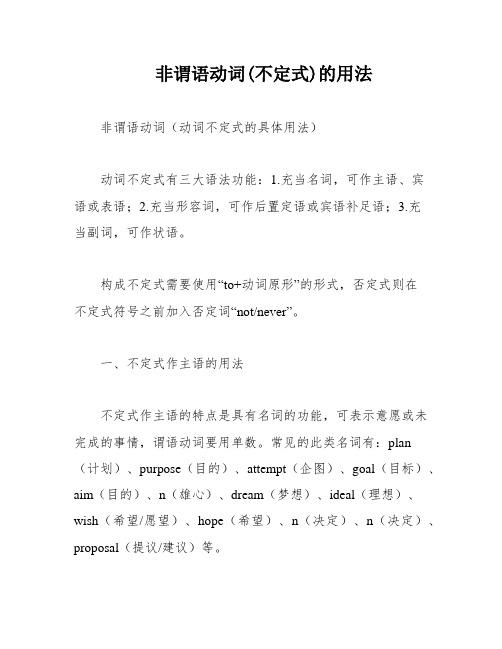
非谓语动词(不定式)的用法非谓语动词(动词不定式的具体用法)动词不定式有三大语法功能:1.充当名词,可作主语、宾语或表语;2.充当形容词,可作后置定语或宾语补足语;3.充当副词,可作状语。
构成不定式需要使用“to+动词原形”的形式,否定式则在不定式符号之前加入否定词“not/never”。
一、不定式作主语的用法不定式作主语的特点是具有名词的功能,可表示意愿或未完成的事情,谓语动词要用单数。
常见的此类名词有:plan(计划)、purpose(目的)、attempt(企图)、goal(目标)、aim(目的)、n(雄心)、dream(梦想)、ideal(理想)、wish(希望/愿望)、hope(希望)、n(决定)、n(决定)、proposal(提议/建议)等。
为了避免主语过长,不定式短语可放在句末,用形式主语“it”代替原来的主语位置,不定式则成为真正的主语。
例如:___.(赢得冠军是我的雄心。
)To master a foreign language is necessary.(掌握一门外语是有必要的。
)To e President of the United States used to be my goal.(过去我的梦想是成为美国总统。
)Speaking perfect English is always my dream.(说一口流利的英语一直是我的梦想。
)It is ___.(保护环境是有必要的。
)There are two special ___:1) It is + adj + of sb + to do sth.2) It is + adj + for sb + to do sth.___ characteristics and differences are:1) If ___ characteristics or traits。
the logical subject of the ___ "of."Examples:It is very affable of you to help me。
非谓语动词用法详解

非谓语动词用法详解动词的非谓语形式有三种:不定式、动名词和分词(一)不定式不定式由“to十动词原形”构成,其否定形式是“not to do”.不定式可以带宾语或状语构成不定式短语,没有人称和数的变化,但有时态和语态的变化.不定式可作主语、宾语、状语、表语和定语,但不能单独作谓语.不定式的逻辑主语有时用“for十名词或代词宾格”构成.1.不定式的用法:l)作主语.不定式短语作主语时,往往放在谓语之后,用it作形式主语.例如:To see is to believe.It is right to give up smoking.2)作宾语.不定式短语作宾语时,如果还带有宾语补足语。
往往把不定式宾语放在宾语补足语之后,而用it作形式宾语.例如:He wanted to go.I find it interesting to study work with him.3)作宾语补足语.例如:He asked me to do the work with him.注意:在feel,hear,listen to,look at,notice, observe,see,watch,have, let,make等词后的补足语中,不定式不带to.但是这些句子如果变成被动结构时,就必须带to.例如I often hear him sing the song.He is often heard to sing the song.注意:不定式动词在介词but,except,besides后面时,如果这些介词之前有行为动词do的各种形式,那么,这些介词后的不定式不带to,否则要带to.如:She could do nothing but cry.What do you like to do besides swim?I have no choice but to go.动词help之后,带to或不带to都可以。
Will you please help me (to) take this suitcase? 请你帮我提一下这个衣箱好吗?She often helps her mother (to) clean their house. 她经常帮助她妈妈打扫房子。
(完整版)非谓语动词(不定式)的用法

非谓语动词(动词不定式的具体用法)Step1. 动词不定式的3大语法功能(1)不定式可充当主语,宾语,表语,具有名词的功能.(2)不定式可充当后置定语或宾语补足语,具有形容词的功能.(3)不定式可充当状语,具有副词的功能..Step2.不定式的构成,即:“不定式符号to+动词原形”.Step3. 不定式的否定式,否定词一定放在不定式符号之前,即:“not/never+不定式+动词原形.一,不定式作主语的用法.特点:“to+动词原形”所形成的形式具有名词功能.名词可在句中充当主语,宾语或者表语,同理,不定式也有相同的功能.1. 不定式作主语的特点:(1)可以表示一种意愿或未完成的事.(2)谓语动词用单数.E g: To win the championship is my ambition.主语系动词表语译文:赢得冠军是我的雄心.E g: To master a foreign language is necessary.主语系动词表语译文:掌握一门外语是有必要的.E g: To become President of the United States used to be my goal.主语谓语宾语译文:过去我的梦想是成为美国总统2. 不定式作主语时,be动词之后的表语若是名词,一定是表示意愿,目的,企图等名词,用来表示尚未完成的事情.常见的此类名词有:plan(计划), purpose(目的),attempt(企图),goal(目标), aim(目的), ambition(雄心),dream(梦想), ideal(理想), wish(希望/愿望),hope(希望), decision(决定),determination (决定),proposal(提议/建议).E g: To speak perfect English is always my dream主语系动词表语译文:说一口流利的英语一直是我的梦想.3. 由于不定式短语作主语,显得主语过长,为了避免头重脚轻,达到句子平衡,把不定式短语放在句末,在原来主语的位置上“it”代替,形式上占一个主语的位置,称之为形式主语,不定式称为真正的主语.E g: It is necessary to protect the environment.形式主语系动词表语不定式作真正主语译文:保护环境是有必要的.4. 不定式作主语的两种特殊结构(1)句型:It is +adj(形容词)+of sb +to do sth.(2) 句型:It is +adj(形容词)+for sb +to do sth.特点和区别:(1)若形容词表示人的本质特征,特性,就用“of”引出的不定式的逻辑主语.A:表示人的本质特征和特性的形容词有:“good; nice; clever; wise; foolish; silly; stupid; rude; (im)polite , careless; careful; affable.E g: It is very affable of you to help me.译文:你真好帮助我.E g: It is very careless of you to lose your wallet.译文:你真粗心大意把钱包丢了.(2) 若形容词表示的不是逻辑主语的特性,而是描述对逻辑主语所做的事情,就用介词“for”,B:常见的此类形容词有:“easy; hard; difficult; heavy; necessary; impossible; important.E g: It is impossible for me to get to the destination on time inan hour.译文:一个小时之内按时达到目的地对我来说是不可能的.E g: It is very difficult for me to work out the math problem.译文:解决这个数学问题对我来说太难了.(3) 形容词表示人的特性的句子可转化成一个不定式作状语的句子,而后者则不能.E g: It is very kind of you to help me with my English可转化为一个不定式作状语的句子= You are very kind tohelp me with my English.二,不定式作宾语的用法.(1)作及物动词的宾语,该及物动词均为表示意愿,企图的动词,表示具体的或者特定的动作,或者是将来的动作.常见的动词如下:want(要); wish(希望); hope(希望); desire (欲望/渴望); intend意图;try(设法); determine(决定); decide(决定); attempt(企图); endeavor(努力); plan(计划); like(喜欢); love(喜欢); expect(期望/盼望);pretend(假装); afford(承担得起); manage(设法); prepare(准备); long (盼望); arrange(安排); promise(答应/许诺); learn(学会);dare(敢);agree(同意);start/begin(开始); fail(失败); refuse(拒绝); 等.E g: I want to take a trip abroad next year.主语及物动词不定式作宾语时间状语译文:明年我要出国旅游.E g: I intend to visit you tomorrow主语及物动词不定式作宾语时间状语译文:我打算明天去拜访你.E g: He tried to kill two birds with one stone.译文:他设法一箭双雕.E g: I expect to get a raise.译文:我渴望获得加薪.E g: I can’t afford to buy a new car.主语及物动词动词不定式作宾语译文:我买不起新车.(2)若作宾语的不定式太长,如果其后还有形容词或名词担当宾语补足语,常用“it”作形式宾语,把不定式短语作真正的宾语后置.基本句式:“主语+及物动词+it(形式宾语)+名词/形容词(宾语补足语)+to+动词原形(真正宾语)”.常见的此类动词有“find(发现); think(认为); believe(相信); consider(认为); deem(认为); feel(觉得); make(使)E g: I think it useful to learn English well.主语及物动词形式宾语宾补不定式作真正的宾语译文:我认为学好英语是很有用的.E g: I deem it necessary to apologize to others.主语及物动词形式宾语宾补不定式作真正的宾语译文:我认为向别人道歉是有必要的.E g: I deem it an honor for me to give this speech.译文:能在这里进行演讲我认为这是我的荣幸.E g: We found it impossible to finish the project in a month.主语及物动词形式宾语宾补不定式作真正的宾语译文:我发现一个月之内完成这个项目是不可能的.E g: I make it a rule to get up early.说明:Make it a rule to+v 表示“把--------当作常例/习惯于-------------”.译文:我习惯早起.E g: The teacher made it a rule to speak only English in class.主语及物动词形式宾语宾补不定式作真正的宾语地点状语.译文:老师规定在课堂上这能讲英语.E g: I felt it stupid for him to talk like that.译文:我觉得他这样讲话挺愚蠢的.(3)疑问代词:“what ; which; whom +动词不定式(to+do)”共同作及物动词的宾语的用法特点:不定式后面的动词一定为及物动词,疑问单词“what ; which; whom”及物动词或者介词的宾语.E g: I can’t decide which one to buy.主语及物动词共同作宾语译文:我决定不了买哪一个.know what to do next.E g: I don’t译文:我不知道下一步该怎么办.E g: I can’t decide whom to turn to for help.译文:我决定不了向谁求救.E g: I hardly know what to say to you.译文:我简直不知道该对你说什么.(4)疑问代词:“what ; which; whom +动词不定式(to+do)”共同作及物动词直接宾语的用法E g: Would you please tell me which course to take?主语及物动词间接宾语直接宾语译文:你能告诉我应该选哪门课程吗?(5)疑问副词:“when; where; how;whether+动词不定式(to+do)”共同作及物动词宾语的用法特点:(1)不定式后面的动词可以为不及物动词.(2)不定式后面的动词也可为及物动词,且后面有宾语.E g: He patiently showed me how to operate the computer.主语状语及物动词间接宾语直接宾语译文:他耐心地教我怎么使用电脑.tell me when to start.E g: He didn’t译文:他并没有告诉我什么时候出发.know whether to go or stay.E g: I don’t译文:我不知道是走还是留.E g: I just wonder where to spend the weekend.译文:我只是想知道该去哪里度过周末.E g: Life is long if you know how to live it.译文:若知如何使用,生命就会长久.三,不定式作表语的用法.特点:(1)主语均为表示:“意愿”或者“企图”的名词.(2)不定式作表语可换作主语.E g: His only wish at present is to sleep.主语时间状语系动词动词不定式作表语译文:他此刻唯一的愿望就是去睡觉.可转化为:To sleep is his only wish at present.E g: His goal is simply to become an excellent English teacher.主语系动词状语动词不定式作表语译文:他的目标就是当一名优秀的英语教师.E g: His resolution is to become a great scientist.主语系动词动词不定式作表语译文:他的志愿时当一名伟大的科学家.E g: My dream is to become a successful businessman.译文:我的愿望是成为一名成功的商人.E g: The problem is to find a solution.译文:问题是得找出一个解决办法.E g: Shaking one’s fist is to show one’s determination.译文:挥拳头是显示一个人的决心.E g: The purpose of yelling English is to build up your confidence.译文:大喊英语的目的是建立你的自信心.不定式作表语的2种特殊情况(1)动词不定式作主语,也可作be动词之后的表语,主语和表语的动词形式一定要对称.E g: To see is to believe不定式作主语系动词不定式作表语译文:眼见为实E g: To love her this way is to worship her.不定式作主语方式状语系动词不定式作表语译文:这样爱他就等于崇拜她.(2)在下列句型中,be动词之后的to可省略,接动词原形作表语.E g: All you have to do is (to) take a good rest.主语系动词表语译文:你所要做的就是要好好的休息.E g: All I can do is (to) wait主语系动词表语译文:我所能做的就是等待.E g:What you should do is simply (to) apologize to him主语系动词状语表语译文:你应该做的事就是向他道歉.四,不定式作后置定语的用法.相当于形容词的功能.特点:(1)动词不定式作定语时一定要放在所修饰词的后面,作后置定语.(2)动词不定式与所修饰的名词之间有动宾关系.(3)不定式后面的动词为及物动词,若为不及物动词,一定要加上相应的介词.E g: I have a pile of homework to do tonight.主语及物动词宾语不定式作后置定语时间状语.译文:今晚我有一大堆的作业要做.不定式作后置定语的特殊用法(1)不定式作后置定语可以等于关系代词作主语所引导的定语从句.E g: I have no friend to advise me.主语谓语宾语不定式作后置定语等价于:I have no friend who can advise me.译文:我没有朋友可以给我忠告.(2)不定式作后置定语可以等于关系代词作宾语所引导的定语从句.E g: I have no one to talk to主语谓语宾语不定式作后置定语等价于:I have no one whom I can talk to.译文:我没有人可以交谈.E g: There are many sights to see here.等价于:There are many sights which we can see here.译文:这里有很多的风景可看.(3)主动的不定式和被动不定式的区别. A: 如果句子的主语是要做那件事的人,就用主动形式.B: 如果句子的主语是要做的动作(或者是接受动作的人或事),就用被动式.E g: I have two coats to wash.E g: Two coats are to be washed.(4) 在:“there be ”结构中的不定式可用主动式,也可用被动式,且意思一样.E g: There is an important thing to do tonight= There is an important thing to be done tonight.(5)不定式修饰序数词一定要放在其后.A:Li was the first to arrive.B: Really? That’s not like him. He’s always the last one to arrive.A: 李是第一个到的.B: 真的吗?那可不像他的作风,他总是最后一个到.五,不定式作状语的用法.特点:不定式作状语多放在被修饰的动词,副词,和形容词之后.注意其逻辑主语必须和句子的主语保持一致.在句中充当状语,表示目的;结果或原因.(1)不定式修饰动词的用法,一定置于该动词之后.E g: We should do whatever we can to save them.主语及物动词宾语从句不定式作目的状语的用法译文:我们应该做些什么才能挽救他们呢.(2) 不定式修饰动词作目的状语的用法.特点:不定式作目的状语,通常置于动词之后,也可置于句首,用逗号与主语隔开.E g: You should work very hard to win the award.主语谓语状语不定式作目的状语等价于:To win the award, you should work very hard译文:为了要赢得这个奖项,你应该努力奋斗.E g: I’ll do everything I can to help you.(目的)译文:我会竭尽全力帮你的.E g: You’re really very kind to say so.(原因)译文:你这么说真是太好了.还有类似不定式短语有:(1)in order to+动词原形..即可放在句首,也可句末.(2)so as to+动词原形.只能放在句末.(3)only to;(4) too-------to 太-------而不能(3)with an eye to +动名词. 只能放在句中. (4)with a view to +动名词. 只能放在句中.E g: He got up early in order to catch the school bus.主语谓语不定式作目的状语译文:他早起的目的就是能搭上校车.(3)不定式修饰形容词,一般置于该形容词之后.特点:一般表示一种结果.E g: He is able to do amazing things.主语系动词表语不定式作结果的用法译文:他能成就伟业.E g: He is apt to lie to me .主语系动词表语不定式作结果的用法.译文:他爱向我撒谎.E g: She was prepared to face the music.译文:她准备好面对后果.疯狂操练:I’m determined to conquer English. 我决心攻克英文I’m determined to master pronunciation. 我决心攻克发音.I’m determined to speak good English. 我决心说好英语.I’m determined to become a grammar king. 我决心成为语法大王I’m determined to command a lot of words. 我决心掌握大量词汇.I’m determined to write beautiful articles. 我决心写出漂亮文章.I’m determined to communicate with the world. 我决心与全世界沟通.(4)不定式修饰副词,一定置于该副词之后. 特点:一般表示一种结果.E g: He is old enough to go swimming alone.主语系动词表语状语(副词)不定式作结果的用法. 译文:他长大了,足以单独一个人去游泳.五,不定式作宾语补足语的用法.(1)具有使役动词意味的及物动词,加上宾语之后,要用不定式短语作宾语补足语.此类动词有:1) cause/get 促使-----------;2) lead引导--------说明:‘加上宾语之后,可接to引导的不定式短语,但此时to视为介词,接动名词作其宾语”;3) allow/permit允许------4)advise 劝告---------5)persuade说服----------6)enable使能够----------7)tell告诉-------8)beg/ask请求--------9)order命令---------10)want/wish/expect/intend期望---------11)force 迫使----------------.12)encourage鼓励-------.E g: The sad story caused him to cry.主语及物动词宾语不定式作宾语补足语译文:这个悲惨的故事使他哭了.E g: His timely help enabled me to finish the project in advance.主语及物动词宾语不定式作宾补时间状语译文:他及时的帮助使我能提前完成这个项目.allow me to smoke in the office.E g: They don’t主语及物动词宾语不定式作宾补地点状语译文:他们不允许我在办公室里吸烟.E g: I ask my students to yell English every morning.主语及物动词宾语不定式作宾补时间状语译文:我要求我的学生每天早上都大喊英语.E g: My parents want me to become a great lawyer in thefuture.译文:我的父母希望我将来成为一位很棒的律师.E g: The boss forces his staff to work like a dog for him.译文:老板强迫员工为他拼命干活.E g: My teacher encouraged me to try again.译文:我的老师鼓励我再试一次.(2)使役动词或者是感官动词,动词不定式作宾语补足语“to”要省略.巧记不定式作宾补省略“to”的两大规则A:“注意让‘买客’听听看看这块表有啥感觉不带“土”B: 五看(see; watch; notice; observe; look at); 三让(let; make; have);两听(hear; listen to); 一感觉(feel); 一发现(find); 半个帮(help).1)感官动词,宾语补足语接原型动词,表示已发生的事实..若出现在被动语态中,“to”要还原.E g: I noticed a thief slip into my room just now.主语及物动词宾语省略不定式原型动词作宾补时间状语译文:我刚才注意一个贼溜进我的房间了.E g: I never heard him speak English.译文:我从未听过他说英语.E g: The man was seen to leave the accident.(被动语态中不定式要还原)译文:有人看见他离开事故现场.2)使役动词(make/ let/ have)的具体用法.{1}“make”的常见用法. 若出现被动语态时“to”要还原.※make +宾语+宾补(形容词)E g: The news made me happy.主语及物动词宾语形容词从当宾语补足语.译文:这则消息使我很开心.※make+宾语+宾补(省略“to”的动词原形).疯狂操练 E g: My mother made me walk the dog. My father made me sweep the floor. My grandmother made me wash the dishes. My grandfather made me buy him cigarettes. Everyonein me family made me do something yesterday. I really enjoy helping other people.译文:我妈妈让我去遛狗.我爸爸让我擦地板.我奶奶让我洗碗.我爷爷让我给他买烟.昨天家里的所有人都让我干活了.我真的很乐意帮助他人.E g: These workers are made to work at least 18 hours each day.译文:这些工人被迫每天至少工作18小时.{2}“let”的用法. 很少出现被动语态中.※Let’s +动词原形. 让我们一起-------------------------E g: Let’s have dinner together tonight. 译文:让我们今晚一起吃晚饭.※Let us +动词原形. 让我们一起------------E g: Let us help Tom clean the room. 译文:让我们大家一起帮助汤姆打扫房间.※Let sb++动词原形. 让某人做某事.E g: Let me help you. 译文:让我来帮助你. {3}“have”的用法. 很少出现被动语态中.※have +宾语(人/)+宾补(过去分词充当)表示:请某人做某事※have +宾语(物/)+宾补(过去分词充当)表示:可以用来主语的遭遇或经历,并不是故意让某事发生的.特点:1) 作宾语补足语的动词与宾语之间是被动关系.2)该动作常不属于主语的动作.E g: I had my hair cut yesterday主语使役动词宾语过去分词作宾补时间状语译文:我昨天理的发.E g: Please have the boy taken to the station.译文:请找人把这男孩带到E g: The old man had his leg broken when he fell off the bike.译文:那老人从自行车上摔下来时把腿摔断了.※have+宾语(人/)+宾补(动词原形)表示“让某人做某事”E g: The director had his assistant pick up some hot dogs for the meeting.译文:主管让他的助理为这次会议准备一些热狗.※have+宾语(人/物)+宾补(动名词)表示:“让某人或某事不停地,或者一次又一次地进行某一动作.E g: He had us laughing all through. 译文:整顿饭期间他让我们笑个不停.六,不定式充当独立主格的用法.特点:不定式可以在句中充当独立成分,用来说明说话人的态度,对全句进行解释常见的有:“to be frank; to be honest; to tell the truth; to be blunt”等E g: To tell the truth, I have no money with me today.译文:我今天一分钱也没有带.E g: To be frank, you need to lose weight.译文:坦白说,你真的需要减肥.E g: To be blunt, that’s a stupid idea.译文:老实说,这想法真愚蠢.七,原型不定式的特殊结构.下列为与原型不定式连用的特殊结构.这些结构经常出现在各类英语考试中,务必要牢记.1): do nothing but +动词原形. 除了-----,无所事事.E g: He did nothing but eat all day.译文:他整天什么也不做,只是吃.分析步骤如下:第一步:句中的but 可视为并列连词,连接对等且形态相同的词类did,即He did nothing but did----------.第二步:我们知道do/does/did用于肯定句中,可视为强调性的助动词,之后要接动词原形.试比较:未强调前: He works hard. 他用功. 强调后:He does work hard. 他的确很用功.第三步:因此,在He did nothing but did----------中,did之后要接动词原形.即He did nothing but did eat all day.第四步:并列连词but之后相同的词类可以省略.本句中第一个did为不及物动词的一半过去时,而第二个did则为强调性的助动词,虽然性质不一,但外形相同,故第二个did可省略,即:“He did nothing but eat all day”.2): Choose/expect/want/desire nothing but to+动词原形.E g: He wanted nothing but to sleep. 译文:他什么都不要,只想睡觉.3): I have no choice but to+动词原形. 除了-------我别无选择.E g: I have no choice but to wait for the result.译文:除了等待结果我别无选择.4): be interested in nothing but+动名词/名词. 除了-----对什么也不感兴趣.E g: He is interested in nothing but singing.译文:他除了唱歌外,对什么都不感兴趣.5)enjoy nothing but+动名词/名词. 除了-----------对什么都不喜欢.E g: I enjoy nothing but dancing.译文:我除了跳舞外什么都不喜欢.6)cannot but+动词原形=cannot help/stop/ resist+动名词=cannot help but+动词原形.意思为:“不得不/忍不住-----------------”.E g: When I heard the story, I couldn’tb ut laugh/I couldn’thelp but laugh. 译文:我听到这个故help laughing/I couldn’t事,忍不住笑了出来.八,在下列含有to的动词短语中to 是介词的有,注意:“介词后面要接名词、宾格代词、动名词”如下:“1)be used to----------习惯于-------; 2)devote--------to献身于-------;3)get down to-------开始、着手-------;4)lookforward to-----期望、期盼;5)object to-----反对;6)be opposed to-----反对; 7)pay attention to-------注意、关注; 8)stick to---------;9)apply------to集中精力、专注坚持10)accustom-------to使------习惯于;11)help oneself to ------请随便------”等.E g: You should pay more attention to your health.译文:你应该多加注意身体.疯狂操练:You should pay more attention to your pronunciation. 你要多留意你的发音.You should pay more attention to your kids. 你要多留心你的孩子.You should pay more attention to your teeth. 你要多注意保护牙齿.You should pay more attention to your family.你要多关心家人. You should pay more attention to your schoolwork.你要多花心思在学业上.You should pay more attention to our environment.我们应该多关注保护环境.E g: She applied herself to learning English.译文:她刻苦学习英语.E g: You must accustom yourself to getting up early译文:你必须习惯早起.E g: I’ve been looking forward to hearing from you.译文:我一直期望收到你的来信.疯狂操练:Help yourself to something to drink. 你自己随便喝点什么,别客气.Help yourself to something to eat.你自己随便吃点什么,别客气.Make yourself at home. 别拘束.Sit down and relax for a while.坐下来放松一下.My home is your home.我的家就是你的家.。
非谓语动词的用法详解

非谓语动词非谓语动词有3种:不定式,动名词和分词。
不定式不定式由“to do”构成,其否定式“not to do”。
不定式可带宾语或状语构成不定式短语,没有人称和数的变化,但有语态的变化,不定式可作主,宾,定,状,补,表,不能单独作谓语。
一. 不定式的用法1 作主语To see is to believe.It is right to give up smoking.2 作表语My job is to teach English.3 作宾语He wanted to go.I find it hard to work with him.常见用不定式作宾语的动词:want, wish, like, decide, help, ask, agree, afford, arrange, care, determine, fail, guarantee, hesitate, hope, hurry, manage, offer, pretend, promise, seek, prepare, refuse, swear, expec t, plan, would like, make up one’s mind, be determined4 作补语He asked me to open the door.常见用不定式作宾补的动词:advise, allow, permit, forbid, ask, beg, encourage, expect, force, get, invite, like, order, peruade, prefer, require, teach, tell, want, warn, wish, considerpractice:* 在感官动词feel, hear, listen to, see, look, notice, watch, observe,和使役动词make, let, have等后的补语中,不定式不带to,但这些句子变成被动结构时,就必须带toI often hear him sing the song.He is often heard to sing the song.5 作定语He is looking for a room to live in.There’s nothing to worry about.不定式作定语的用法:6 作状语I came here to see you. (表目的) in order to / so as toWe were excited to hear the news. (表原因)He hurried to the school (only) to find nobody there.(表结果7 疑问词+不定式,在句中起名词作用,可作主,宾,表He didn’t know what to say.How to solve the problem is very important.My question is when to start.8 作插入语To tell the truth, I don’t agree with you.to be sure to be frank to sum up to begin /start withto make matters worse to be brief二不定式的时态,语态1 一般式:表示的动作与谓语动作同时或在它之后发生He pretended not to know me when I met him in the street.2 进行式:表示动作发生时,不定式动作正在发生He pretended to be reading English when I entered the classroom.3 完成式:表示动作发生在谓语动作之前He is said to have learned English in Britain for a year.A railway is said to be being built now.No harm seems to have been done.四不定式的省略为避免重复可用to来代替前面的不定式,常出现在下列动词后expect, hope, wish, mean, prefer, care, forget, want, try 或出现在be glad, be happy, would like/love后eg: I haven’t been to Hong Kong, but I wish to.--- Would you come to the party?--- I’d love to, but…如果在省略不定式中含有be, have, have been 等系动词或助动词,这些词要保留。
非谓语动词中的动词不定式和动名词用法详解

非谓语动词中的动词不定式和动名词用法详解动词不定式和动名词是非谓语动词的两种形式。
它们在句子中可以充当名词、形容词或副词,具有一定的独立性和灵活性。
本文将详细解释动词不定式和动名词的用法,并举例说明。
动词不定式用法:动词不定式一般由to + 动词原形构成,常用的用法有以下几种:1. 作主语:动词不定式作为句子的主语时,常放在句首,如:To learn English is important.(学习英语很重要。
)2. 作宾语:动词不定式可以作为及物动词的宾语,如:I want to go shopping.(我想去购物。
)3. 作表语:动词不定式可以作为主语后面的表语,如:Her dream is to become a doctor.(她的梦想是成为一名医生。
)4. 作定语:动词不定式可以修饰名词,常放在名词前面,如:Please give me something to eat.(请给我一些吃的。
)5. 作状语:动词不定式可以表示目的、原因、结果、方式等,如:He went to the library to borrow some books.(他去图书馆借书。
)6. 作补语:动词不定式可以作及物动词的宾语补足语,如:They made him apologize for his behavior.(他们要求他为自己的行为道歉。
)动名词用法:动名词是动词加-ing形式构成的名词,常用的用法有以下几种:1. 作主语:动名词可以作为句子的主语,如:Swimming is good exercise.(游泳是很好的锻炼。
)2. 作宾语:动名词可以作及物动词的宾语,如:I enjoy singing.(我喜欢唱歌。
)3. 作表语:动名词可以作为主语后面的表语,如:His hobby is playing basketball.(他的爱好是打篮球。
)4. 作定语:动名词可以修饰名词,常放在名词前面,如:I have a swimming lesson this afternoon.(我今天下午有一堂游泳课。
(完整版)非谓语动词之动词不定式被动语态形

非谓语动词之动词不定式被动语态形一、复习各种时态的被动语态★被动语态的基本结构: be+ done(以 the book , publish 为例)一般现在/过去时:The book is/ was published。
一般/过去将来时:The book will/would be published.The book is/was going to be published.现在/过去进行时:The book is/was being published.现在/过去完成时:The book has/had been published.情态动词:The book can/could/may/might…be published。
二、不定式的被动式的基础知识:2)完成式:(not/ never) to have been done (表示不定式动作发生在谓语动词之前)三、▲通常在believe, suppose, say, report等动词构成的句子中可以进行主动语态到被动语态以及被动语态和动词不定式的转换.如:They say that Mike is sick in bed.=It is said that Mike is sick in bed.=Mike is said to be sick in bed.据说麦克卧床不起。
People believe that he was killed.=It is believed that he was killed.=He is believed to have been killed。
大家相信他被杀了.四、当不定式的逻辑主语是不定式所表示的动作的承受者而非发出者时,不定式一般要采用被动形式(to be done).语法功能:1.作主语:It is an honour for me to be asked to speak here.2.作宾语:She asked to be sent to work in Xinjiang。
非谓语动词用法讲义(精)

非谓语动词用法讲义第一部分: 非谓语动词用法详解一、不定式的用法1. 不定式的构成不定式是由不定式符号to+动词原形构成,在某些情况下to也可省略。
不定式一般有时式和语态的变化,通常有下表中的几种形式(以do为例):主动式被动式一般式to do to be done完成式to have done to have been done进行式to be doing /完成进行式to have been doing /1) 不定式的一般式不定式的一般式所表示的动作通常与主要谓语的动作同时或几乎同时发生,或是在它之后发生。
如:They invited us to go there this summer. 他们邀请我们今年夏天去那儿。
He stood aside for me to pass. 他站到一边让我通过。
2) 不定式的完成式不定式的完成式所表示的动作在谓语所表示的动作之前发生,它在句中可作表语、状语、宾语,有时也可作主语、定语等。
如:She seemed to have heard about this matter. 她似乎已听说过这件事。
I am sorry to have kept you waiting so long. 我很抱歉让你等了这么久。
I meant to have told you about it, but I happened to have an important thing to do.我本来想告诉你这件事的,但我碰巧有一件重要的事要做。
It has been an honor for me to have traveled so much in your country.对我来说,在你们国家旅行这么多地方是一件很荣幸的事情。
3) 不定式的进行式不定式的进行式表示正在进行的与谓语动词同时发生的动作。
它在句中可以用作除谓语以外的所有成分。
如:It’s nice of you to be helping us these days. 你真好,这些天一直帮我们。
非谓语动词---不定式的用法

不定式作非谓语动词一、不定式的定义及构成:不定式是一种非限定性动词,即在句中不能单独充当谓语的动词。
肯定形式:to + 动词原形否定形式:not to + 动词原形被动形式:to be + done(动词过去分词)期中to为不定式符号,本身无意义。
二、不定式的时态和语态不定式虽没有人称和数的变化,但所表达的动作仍具有时间先后顺序,主动、被动形式。
具体形式如下表1) 不定式的一般式动词不定式的一般式表示的动作通常与谓语动词所表示的动作同事发生或在其后发生。
We try to finish the task on time. 我们试图及时完成任务。
I hope to see you next week. 我希望下周能见到你。
2)动词不定式的进行式动词不定式的进行式所表示的动作一般与谓语动词所表示的动作同时发生He seems to be following us. 他好像正在跟着我们。
3)不定式的完成式不定式的完成式表示的动作发生在谓语动词表示的动作之前I’m so sorry to have given you so much trouble.很抱歉,给你添了那么多的麻烦。
4)动词不定式的被动形式○1动词不定式的一般式被动语态通常表示将来的动作。
The flowers need to be watered. 这些花需要浇水了。
○2不定式的完成式被动语态表示的动作发生在谓语动作之前。
The room seems to have been tidied up already. 这个房子似乎已经整理过了。
三、不定式的用法1)作主语动词不定式作主语,相当于名词或代词的作用To learn an art well is very hard. 学好一门艺术很难。
★动词不定式作主语往往用形式主语it代替,然后不定式置于句尾。
上面的句子可改写为It is very hard to learn an art well.2) 作宾语动词不定式一般作动词或介词的宾语I really want to watch the football match.He has no idea of how to answer this question.3) 作宾语补足语○1后接带to的不定式作宾语补足语的动词有:ask, tell, beg, like, love, would like, order, teach, want, allow, encourage, wish等。
非谓语动词 之动词不定式(to do)的用法
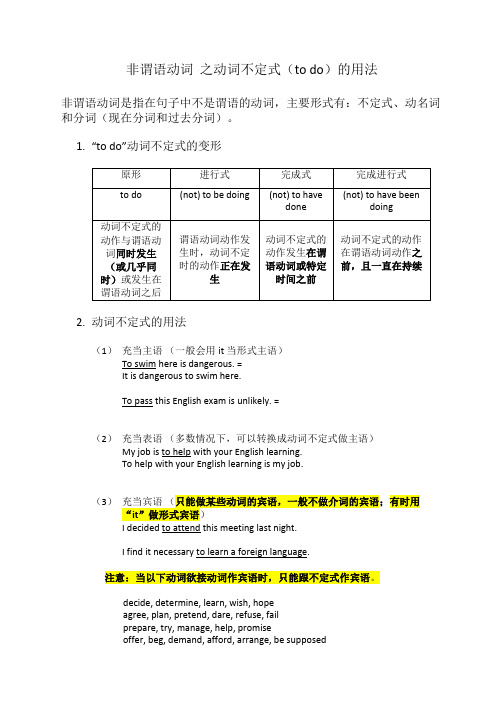
非谓语动词之动词不定式(to do)的用法非谓语动词是指在句子中不是谓语的动词,主要形式有:不定式、动名词和分词(现在分词和过去分词)。
1.“to do”动词不定式的变形2.动词不定式的用法(1)充当主语(一般会用it 当形式主语)To swim here is dangerous. =It is dangerous to swim here.To pass this English exam is unlikely. =(2)充当表语(多数情况下,可以转换成动词不定式做主语)My job is to help with your English learning.To help with your English learning is my job.(3)充当宾语(只能做某些动词的宾语,一般不做介词的宾语;有时用“it”做形式宾语)I decided to attend this meeting last night.I find it necessary to learn a foreign language.注意:当以下动词欲接动词作宾语时,只能跟不定式作宾语。
decide, determine, learn, wish, hopeagree, plan, pretend, dare, refuse, failprepare, try, manage, help, promiseoffer, beg, demand, afford, arrange, be supposed(4)充当宾语补足语I persuaded him to make a speech in public.注意:在感官动词/使役动词/help后(see, hear, watch, notice, make,have, let后不定式做宾补时,可省略“to”)I saw them have a disagreement on who should sweep the floor. (我看到了他们争论的整个过程)但,感官动词后面也可接Ving形式,表示正在进行。
不定式非谓语动词用法解析

不定式非谓语动词用法解析不定式是一种特殊的非谓语动词形式,它可以不受主语和时态限制地在句子中充当名词、形容词或副词。
在英语中,不定式通常由“to”加动词原形构成,形式为“to + 动词原形”。
一、作名词用法1. 作主语不定式作主语时,常用于句子的开头,并且常常需要用形式主语“it”来代替。
例如:To learn a foreign language is not easy.(学习外语并不容易。
)2. 作宾语不定式作及物动词的宾语时,常位于动词之后。
例如:I want to go shopping.(我想去购物。
)3. 作介词的宾语不定式可以作为某些介词的宾语,常用的介词有:for, about, after, before, without, etc.例如:Thank you for helping me.(谢谢你帮助我。
)二、作形容词用法1. 作后置定语不定式可以用来修饰名词或代词,放在被修饰的名词或代词之后。
例如:I have a book to read.(我有一本书要读。
)2. 作表语不定式可以作为系动词的表语。
例如:Her dream is to become a doctor.(她的梦想是成为一名医生。
)三、作副词用法1. 修饰动词不定式可以修饰动词,表示目的、结果或原因。
例如:He went to the supermarket to buy some groceries.(他去超市买了些杂货。
)2. 修饰形容词或副词不定式可以修饰形容词或副词,常用于句子中den 给出愿望、建议或批评的时候。
例如:She is too young to go to school.(她太小不能上学。
)四、特殊用法1. “动词 + 宾语 + 不定式”某些动词后面接宾语时,可以通过不定式的形式来表示宾语的动作或状态。
常见的动词有:ask, tell, want, wish, advise, encourage, allow, etc.例如:She asked me to help her.(她请我帮她。
非谓语动词用法详解不定式作定语
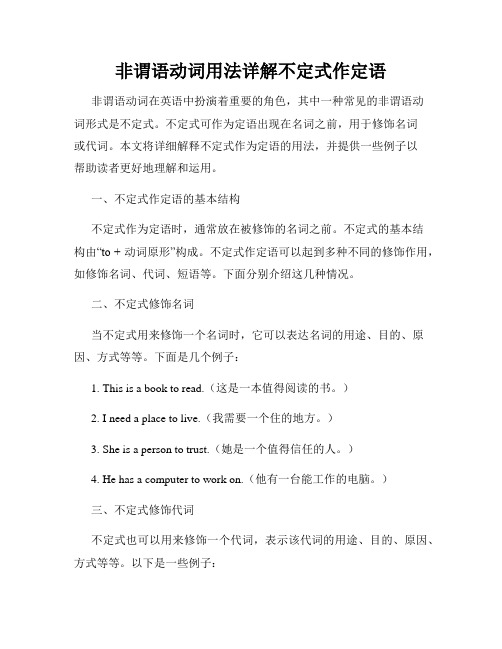
非谓语动词用法详解不定式作定语非谓语动词在英语中扮演着重要的角色,其中一种常见的非谓语动词形式是不定式。
不定式可作为定语出现在名词之前,用于修饰名词或代词。
本文将详细解释不定式作为定语的用法,并提供一些例子以帮助读者更好地理解和运用。
一、不定式作定语的基本结构不定式作为定语时,通常放在被修饰的名词之前。
不定式的基本结构由“to + 动词原形”构成。
不定式作定语可以起到多种不同的修饰作用,如修饰名词、代词、短语等。
下面分别介绍这几种情况。
二、不定式修饰名词当不定式用来修饰一个名词时,它可以表达名词的用途、目的、原因、方式等等。
下面是几个例子:1. This is a book to read.(这是一本值得阅读的书。
)2. I need a place to live.(我需要一个住的地方。
)3. She is a person to trust.(她是一个值得信任的人。
)4. He has a computer to work on.(他有一台能工作的电脑。
)三、不定式修饰代词不定式也可以用来修饰一个代词,表示该代词的用途、目的、原因、方式等等。
以下是一些例子:1. I have something to tell you.(我有事要告诉你。
)2. He needs someone to help him.(他需要有人帮助他。
)3. They are looking for a house to live In.(他们正在寻找一座住的房子。
)四、不定式修饰短语不定式还可以修饰一个短语或者从句,同样地,它表示这个短语的用途、目的、原因、方式等。
以下是一些例子:1. He came here to study English.(他来这里是为了学习英语。
)2. They left early to catch the train.(他们早点离开是为了赶火车。
)3. I need more time to finish my work.(我需要更多时间来完成我的工作。
非谓语动词用法详解不定式作主语
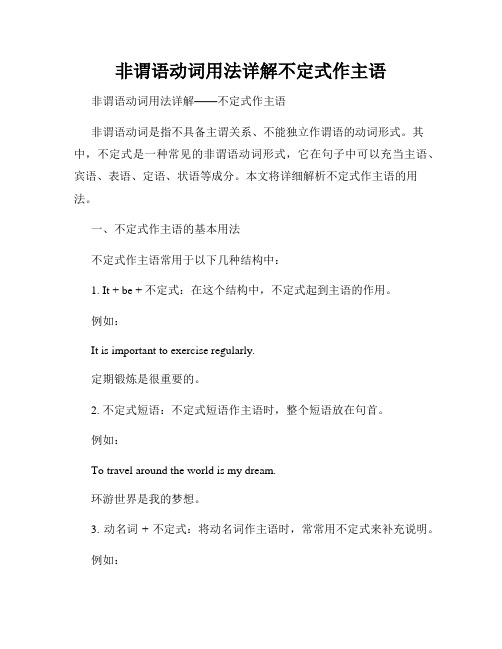
非谓语动词用法详解不定式作主语非谓语动词用法详解——不定式作主语非谓语动词是指不具备主谓关系、不能独立作谓语的动词形式。
其中,不定式是一种常见的非谓语动词形式,它在句子中可以充当主语、宾语、表语、定语、状语等成分。
本文将详细解析不定式作主语的用法。
一、不定式作主语的基本用法不定式作主语常用于以下几种结构中:1. It + be + 不定式:在这个结构中,不定式起到主语的作用。
例如:It is important to exercise regularly.定期锻炼是很重要的。
2. 不定式短语:不定式短语作主语时,整个短语放在句首。
例如:To travel around the world is my dream.环游世界是我的梦想。
3. 动名词 + 不定式:将动名词作主语时,常常用不定式来补充说明。
例如:Taking risks is the key to success.冒险是成功的关键。
二、不定式作主语的特殊用法1. 用于there be 句型There be 句型表示“存在某物”,当不定式短语作主语时,表示某物的存在。
例如:There is much work to do.有很多工作要做。
2. 用于情态动词情态动词后接不定式作主语,表示建议、要求、命令等含义。
例如:You should try to do your best.你应该尽力而为。
三、不定式作主语的注意事项1. 与谓语动词保持一致不定式作主语时,要与谓语动词的主语保持一致。
例如:To work hard is important. (单数主语)Working hard is important.(复数主语)2. 换位不定式在句子中,有时为了避免主语过长或句子结构累赘,可将不定式短语放在句尾。
例如:It is important to exercise regularly.(正常结构)To exercise regularly is important.(换位结构)3. 主谓一致性不定式作主语时,谓语动词的单复数形式根据不定式所表示的动作或状态而定。
(完整版)非谓语动词之动词不定式被动语态形

非谓语动词之动词不定式被动语态形一、复习各种时态的被动语态★被动语态的基本结构: be+ done(以the book , publish 为例)一般现在/过去时:The book is/ was published.一般/过去将来时:The book will/would be published.The book is/was going to be published.现在/过去进行时:The book is/was being published.现在/过去完成时:The book has/had been published.情态动词:The book can/could/may/might…be published.1)一般式:(not/never )to be done2)完成式:(not/ never)to have been done (表示不定式动作发生在谓语动词之前)三、▲通常在believe, suppose, say, report等动词构成的句子中可以进行主动语态到被动语态以及被动语态和动词不定式的转换.如:They say that Mike is sick in bed.=It is said that Mike is sick in bed.=Mike is said to be sick in bed.据说麦克卧床不起.People believe that he was killed.=It is believed that he was killed.=He is believed to have been killed.大家相信他被杀了.四、当不定式的逻辑主语是不定式所表示的动作的承受者而非发出者时,不定式一般要采用被动形式(to be done).语法功能:1.作主语:It is an honour for me to be asked to speak here.2.作宾语:She asked to be sent to work in Xinjiang.3.构成复合宾语:He wanted the letter to be typed at once.She didn’t like herself to be praised like that.4.构成复合谓语:The books are not allowed to be taken out of the room.5.作定语:Are you going to the meeting to be held in the teachers’ office?6.作状语:She was too young to be assigned such work.五、不定式有时还可以有完成式的被动式to have been done(表示该动作是发生在主句之前的一个被动动作),在句中作主语、宾语、定语,或者构成复合宾语、复合谓语等,如:It is a good thing for him to have been criticized.(主语)She preferred to have been given heavier work to do. (宾语))He thought it an honour to have been invited to the party. (复合宾语)The book is said to have been translated into many languages. (复合谓语)She was the first woman to have been elected to such a post. (定语)六、不定式的主动形式表示被动1.There be 结构中,用不定式的主动和被动式来修饰主语,区别不大。
非谓语动词用法精讲不定式的用法和常见结构
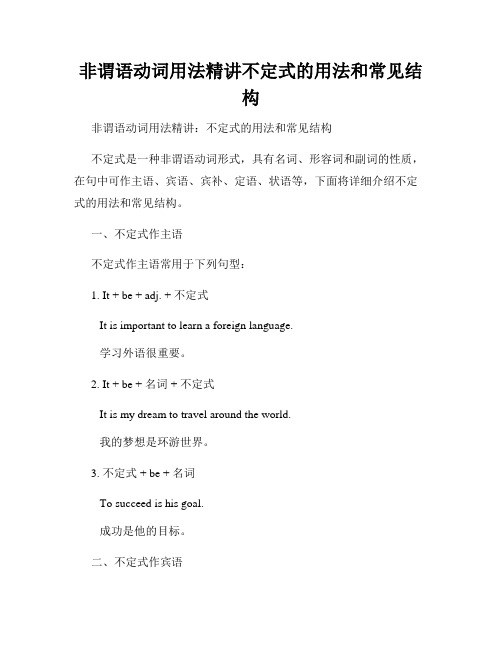
非谓语动词用法精讲不定式的用法和常见结构非谓语动词用法精讲:不定式的用法和常见结构不定式是一种非谓语动词形式,具有名词、形容词和副词的性质,在句中可作主语、宾语、宾补、定语、状语等,下面将详细介绍不定式的用法和常见结构。
一、不定式作主语不定式作主语常用于下列句型:1. It + be + adj. + 不定式It is important to learn a foreign language.学习外语很重要。
2. It + be + 名词 + 不定式It is my dream to travel around the world.我的梦想是环游世界。
3. 不定式 + be + 名词To succeed is his goal.成功是他的目标。
二、不定式作宾语不定式作宾语常用于下列动词后面:1. 希望类:hope, expect, want, wish, would like等I hope to see you soon.我希望很快见到你。
2. 决定类:decide, plan, choose, determine等They decided to go on a trip next week.他们决定下周去旅行。
3. 帮助类:help, teach, show, enable等My teacher taught me how to swim.我的老师教我游泳。
4. 开始类:begin, start, continue等He started to play the piano at the age of six.他六岁开始学习弹钢琴。
5. 喜欢类:like, love, enjoy, prefer等I prefer to stay at home on weekends.我周末更喜欢待在家里。
三、不定式作宾语补足语不定式作宾语补足语常用于使役动词后,表示被动或被迫的意义。
1. 使役动词:make, let, have, get等My father made me clean my room.父亲让我打扫了房间。
非谓语动词 之动词不定式(to do)的用法

非谓语动词之动词不定式(to do)的用法非谓语动词是指在句子中不是谓语的动词,主要形式有:不定式、动名词和分词(现在分词和过去分词)。
1.“to do”动词不定式的变形2.动词不定式的用法(1)充当主语(一般会用it 当形式主语)To swim here is dangerous. =It is dangerous to swim here.To pass this English exam is unlikely. =(2)充当表语(多数情况下,可以转换成动词不定式做主语)My job is to help with your English learning.To help with your English learning is my job.(3)充当宾语(只能做某些动词的宾语,一般不做介词的宾语;有时用“it”做形式宾语)I decided to attend this meeting last night.I find it necessary to learn a foreign language.注意:当以下动词欲接动词作宾语时,只能跟不定式作宾语。
decide, determine, learn, wish, hopeagree, plan, pretend, dare, refuse, failprepare, try, manage, help, promiseoffer, beg, demand, afford, arrange, be supposed(4)充当宾语补足语I persuaded him to make a speech in public.注意:在感官动词/使役动词/help后(see, hear, watch, notice, make,have, let后不定式做宾补时,可省略“to”)I saw them have a disagreement on who should sweep the floor. (我看到了他们争论的整个过程)但,感官动词后面也可接Ving形式,表示正在进行。
- 1、下载文档前请自行甄别文档内容的完整性,平台不提供额外的编辑、内容补充、找答案等附加服务。
- 2、"仅部分预览"的文档,不可在线预览部分如存在完整性等问题,可反馈申请退款(可完整预览的文档不适用该条件!)。
- 3、如文档侵犯您的权益,请联系客服反馈,我们会尽快为您处理(人工客服工作时间:9:00-18:30)。
(完整)非谓语动词之不定式用法详解定义动词不定式与动名词,分词一样是动词的一种非谓语形式,它与动词原形同行,但它前面一般带有一个不定式的符号“to”,我们为了把它与介词的to 区别开来,也叫它小品词,它只是一个符号,没有词性,但动词不定式有时也不带to 。
形式1. 不定式作名词的用法不定式在句子中的作用有时和名词相同,在句子中可以当主语,表语,宾语. it 作形式主语而将真正的主语(不定式短语)放在谓语之后。
例如:例2可变为It is important to obey the laws.例3可变为It is impossible to finish so much homework in a day. 常见的带形式主语it 的句型有:句型一:*It is easy (difficult , hard, important , right , wrong, possible, impossible, necessary , unnecessary, foolish , wise, kind , cruel , nice…) to do …句型二:It is a pleasure (pity , pleasant thing, crime, an honor… ) to do sth. 句型三:It takes (sb 。
) some time to do sth 。
花了某人一些时间去做某事 在句型一中我们常用for sb.或of sb 。
来做不定式的逻辑主语.但是什么情况下用for 或of ,主要从以下两个方面来区别: 1两者所使用的形容词不同a.for sb 。
的句型通常使用表示客观情况的形容词。
如easy, difficult, hard , important, possible, impossible , necessary , unnecessary, interesting 等。
·It is important for us to express our opinions 。
对于我们来说表达我们的意见是很重要的。
b.of sb 。
的句型一般用表示主观感情或态度的形容词。
如:good, kind, nice, wise , clever , foolish, right , wrong , careful, careless, polite , impolite 。
·It is clever of him to leave that country 。
对于他来说离开那个国家是聪明的举动。
#注意:不定式做主语时谓语动词用单数。
不定式做主语的句子中又再有一个不定式作表语时,不能用It is…to…的句型. ·To see is to believe. 百闻不如一见。
·I t is to believe to see…( x )2.of sb 。
句型一般都可以换成一个不定式做状语的句子,而for sb.句型则不可以. ·It is impolite of him to say so. 他这样说是不礼貌的.-—-—He is impolite to say so.(o)(因为of sb 。
句型中的形容词impolite 在逻辑上可以视为him 的表语,所以可以改为此句。
)·It is important for him to say so 。
对于他来讲,这么说是非常重要的。
----He is important to say so 。
( X )(因为for sb 。
句型中的形容词important 在逻辑上不可能是him 的表语,所以此句子不成立。
)2·不定式作表语(完整)非谓语动词之不定式用法详解不定式做表语,一般紧跟在系动词如be, seem, remain, appear , get 等后面,用来说明主语的内容.(见上例)2常见的主语 当我们用one’s dream, business, wish, idea , plan, job , work, task, duty,1动词宾语不定式用在及物动词后面担当宾语,常见的及物动词有:want , hope , wish, like , begin(start), try , need , forget ,agree , know, (learn), promise , teach, refuse, help , arrange , dare , decide, determine , fail , manage, offer, prepare , pretend, hate, prefer , continue , ask, mean , choose , expect…a 。
形式宾语 如果宾语有自己的表语时,我们常常先用“it”作形式宾语代表它,而把用作宾语的不·(o )We think it important to obey the laws 。
我们认为遵守法律是十分重要的。
.b.不定式的省略为了避免重复,作宾语的不定式第二次出现的往往省略,只保留不定式符号to : 1)。
下列动词后want, wish, hope, like , hate , plan , try, love.·You can try it again if you want to 。
如果你想试的话,可以再试一天.Have you listened to the music ? No, but I plan to 。
你听那音乐了吗?没听,但我打算听。
2).下列动词后have to (必须),ought (to), need 。
·I didn't want to bother you , but I had to as I forgot the address 。
我本不想打扰您,但我忘了地址了,只好麻烦您了。
3).在be able to ,used to 和be going to 后·Mr 。
Li planed to come but he wasn't able to 。
李先生计划来的,但没来成。
Shanghai is not the city as it used to. 上海再也不是以前那样的城市了.2介词宾语不定式除了可以当及物动词的宾语外,还可以作but , except, besides 等的介词的宾语。
(完整)非谓语动词之不定式用法详解What do you like to do besides play balls? 除了玩球,你还喜欢做什么?There was nothing for the students to do except read the books aloud .The boy has his own idea of how to finish it。
这个男孩对怎样完成这项工作有他自己的想法。
2.不定式作形容词的用法不定式有时起形容词作用修饰名词或代词,在句子中担任定语。
不定式作定语时它的位置是在它所修饰词的后面,而且往往放在其它后置定语的后面,而不能放在所修饰的词的前面,这一点应引起注意。
1。
动宾关系和主谓关系He alwayshas a lot ofmeetingsto attend.他总是有许多会要参加。
名词:to attend的逻辑上的宾语。
定语不定式作定语时,它所修饰的名词或代词和不定式形成动宾关系或主谓关系。
例如上述句子不定式to attend 作名词meeting的定语,attend是及物动词,那么meeting是to attend的逻辑上的宾语,就是说你可以想象这句子为to attend meetings(出席会议),不定式和它所修饰的名词形成动宾关系。
1。
名词或代词+不定式(to +不及物动词+介词)如果做定语用的不定式是不及物动词,就要在这个不及物动词后面加上介词,使被修饰的这个词成为这个介词的逻辑宾语。
·He is looking for a roomto live in. 他正在找一个住的房间不及物动词+介词不定式live是不及物动词需要加上一个适当的介词in,使被修饰的名词room成为介词in的逻辑宾语(介词宾语)即to live in a room (o)而不能说live a room (x)2。
名词或代词(地点,工具等)+不定式( to + 动作性动词 ) +介词另外有时不定式所修饰的名词或代词是不定式动作的地点,工具等,不定式后面也应该有必要的介词.·Please pass me some paper to write on . 请递给我一些写字的纸。
paper作介词on的逻辑主语,即:to write on some paper ...(O)虽然write 可以作及物动词,但paper不能作write的逻辑宾语,所以:to write some paper (x)·Please lend me something to write with。
请借给我写字用的东西。
Something作介词with的逻辑宾语,可以理解为:to write with something 用某东西(铅笔,钢笔,粉笔等等供写字用的)写.但如果没有with意思就不同了,变成了:to3·The factory to produce electricity will be set up next year. 一座发电厂明年将要建起来。
----—-—A factory (that)which is to produce electricity will be set up next year。
这里(that)which指的是工厂,所以可以理解为factory(工厂)是不定式to produce electricity (发电)的逻辑上的主语。
4.在主谓关系中还包括当不定式所修饰的是序数词或是形容词最高级所修饰的名词时,或者这个名词被省略时,这个名词和不定式之间也是逻辑上的主谓关系。
·She is always the last (person) to speak at the meetings. 她总是会上最后一个发言的人.·Li Ming was the first (person) to arrive. 李明是第一个到达的人.2.不定式修饰something, anything, nothing当不定式作形容词修饰something, anything, nothing时当然也要放在这些词后面作后置定语,如果有形容词修饰上述三个词,应该放在他们后面,如果又有形容词又有不定式修饰上述三个词时,词序应为句型:something,( anything, nothing)+形容词+不定式·Do you have anything to read? 你有什么可以读的东西吗?·Do you have anything interesting to read?你有什么有趣的读物吗?注意语序不同,译文(意思)也不同。
